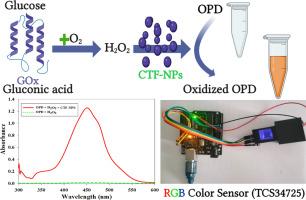Arduino-based portable point-of-care colorimetric glucose biosensor using nanozyme with enhanced peroxidase-like activity
IF 3.7
Q1 CHEMISTRY, ANALYTICAL
引用次数: 0
Abstract
Nanozymes engineered to mimic natural enzyme catalysis have emerged as promising alternatives due to their enhanced stability, cost-effectiveness, and tunable catalytic properties compared to biological enzymes. Developing nanozymes with well-defined porous structures and heteroatom doping is key to improving catalytic efficiency and selectivity particularly for applications in biosensing. Nanotechnology has become a key enabler in advancing catalysis, biosensing, and environmental monitoring thanks to the exceptional properties of nanomaterials such as large surface area, customizable optical characteristics, and enhanced catalytic activity. In this study, a novel nanozyme platform based on creatinine–thiourea–FeCl3 nanoparticles (CTF-NPs) was developed via a one-step pyrolysis method using colloidal silica as a porosity template. The synthesized CTF-NPs were uniformly structured as confirmed by SEM, EDX, FT-IR, UV–Vis, and XRD and featured effective nitrogen, sulfur, and iron doping contributing to their catalytic efficiency. The CTF-NPs exhibited strong peroxidase-like activity catalyzing the colorimetric oxidation of o-phenylenediamine (OPD) in the presence of hydrogen peroxide (H2O2). Kinetic studies revealed a Km of 0.819 mM and a Vmax of 1.620 μM/min outperforming several previously reported nanozyme systems. The sensor displayed a linear detection range of 10–700 μM for H2O2 with an excellent correlation coefficient (r= 0.9975) optimal at pH 4, 40 °C, and 10-minute incubation. Upon coupling with glucose oxidase (GOx), the platform enabled indirect glucose detection via enzymatically generated H2O2 showing a linear range of 100–600 μM with a correlation coefficient of r= 0.9953. The system exhibited high selectivity against common interferents, reproducible fabrication, and reliable performance in spiked human serum samples. Integration of the nanozyme system with a portable RGB color sensor (TCS34725) enabled quantitative, user-friendly, and instrument-free detection supporting the development of accessible point-of-care diagnostics. This work introduces a scalable and robust platform for glucose monitoring with promising implications for diabetes management and decentralized healthcare.

基于arduino的便携式即时比色葡萄糖生物传感器,使用具有增强过氧化物酶样活性的纳米酶
与生物酶相比,纳米酶具有更高的稳定性、成本效益和可调节的催化性能,因此,纳米酶模仿天然酶的催化作用已成为有希望的替代品。开发具有良好多孔结构和杂原子掺杂的纳米酶是提高催化效率和选择性的关键,特别是在生物传感领域的应用。纳米技术已经成为推动催化、生物传感和环境监测的关键推动者,这要归功于纳米材料的特殊特性,如大表面积、可定制的光学特性和增强的催化活性。在这项研究中,以胶体二氧化硅为孔隙模板,通过一步热解的方法,建立了一种基于肌酸酐-硫脲- fecl3纳米颗粒(CTF-NPs)的新型纳米酶平台。经SEM、EDX、FT-IR、UV-Vis和XRD证实,合成的CTF-NPs结构均匀,并且有效掺杂了氮、硫和铁,促进了其催化效率。CTF-NPs表现出较强的过氧化物酶样活性,在过氧化氢(H2O2)存在下催化邻苯二胺(OPD)的比色氧化。动力学研究表明,其Km为0.819 mM, Vmax为1.620 μM/min,优于先前报道的几种纳米酶体系。该传感器对H2O2的线性检测范围为10 ~ 700 μM,在pH值为4、温度为40℃、培养时间为10 min的条件下,相关系数r= 0.9975最优。与葡萄糖氧化酶(GOx)偶联后,该平台可以通过酶促生成的H2O2间接检测葡萄糖,其线性范围为100-600 μM,相关系数为r= 0.9953。该系统对常见干扰具有高选择性,可重复性,在加标的人血清样品中具有可靠的性能。纳米酶系统与便携式RGB颜色传感器(TCS34725)的集成实现了定量,用户友好和无仪器检测,支持无障碍护理点诊断的开发。这项工作介绍了一个可扩展和强大的葡萄糖监测平台,对糖尿病管理和分散医疗保健有很大的影响。
本文章由计算机程序翻译,如有差异,请以英文原文为准。
求助全文
约1分钟内获得全文
求助全文

 求助内容:
求助内容: 应助结果提醒方式:
应助结果提醒方式:


